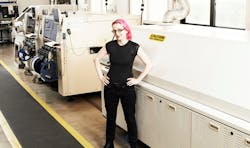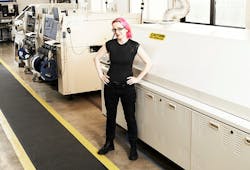Limor Fried is the founder and CEO of Adafruit Industries in New York City. Limor, also known as Ladyada, is an MIT graduate, engineer, hacker, and maker. Her Adafruit is a leading supplier of electronics kits, projects, components, software, and tools for beginning and experienced electronic experimenters, hobbyists, and makers. Limor’s front-line experience makes her well-qualified to comment on the state of the maker space.
Give us a little background on the company and your impetus for starting it.
Back when I was still in school, around 2005, I was having a lot of fun building electronics. I had just been learning as part of my undergraduate internship about microcontrollers and it was tons of fun! Once I built some projects, I would publish them on my website. People loved the projects like my mint-tin MP3 player and emailed asking if I would sell them a kit of parts. Eventually I got so annoyed by all these emails, I started kitting up some simpler projects for sale and they were so popular, it became my life!
Can you tell us the origin of the maker movement and what has made it so successful?
Ever since we as a species have been able to make things and share, it’s in our DNA. And while it’s been called many things, we all make, and with the internet it’s even more apparent.
Is the maker movement growing, shrinking, or staying about the same these days?
It’s definitely growing, and spreading out to a wider audience. There are hundreds of maker spaces around the globe; each one is part of its own community that may hold workshop classes, run mini-maker-faires, or large-scale group projects. We, as humans, have always been makers; now we just have a word for it!
How big is the marketplace in terms of revenue?
Last year, Adafruit made over $45m in revenue, and we employ over 100 people in New York City doing our design, manufacturing, test, packaging and shipping. We have grown every year, there’s always more people who haven’t learned how to solder, craft, sew, or program than people who do!
Describe the typical maker, if that’s possible. Any examples would be good.
The typical maker is a person who likes to make things with their hands, and uses technology to empower their creations. Maybe it’s 3D modeling on a computer, and then printing it out with a 3D printer, or making animations. They could be an artist who likes to screen-print fabric, or a knitter who uses the internet to share patterns. They could be a person who makes assistive technologies for friend or someone who welds ginormous sculptures.
Limor "Ladyada" Fried, founder and CEO of Adafruit.
One of the things you appear to focus on is learning. How do you accomplish that with your products?
We try to make projects and kits that are fun and interesting to build—once built, they can be modified or enhanced. That way people have a chance to build on something that works and is well-documented. It’s more interesting to look at something that’s already well-designed; see how the engineer who made it came up with each step. (This is why it’s so much fun to take stuff apart!) We have a community of people who modify and hack our kits, and then share what they’ve done on our weekly Show-and-Tell video hangout.
What are some of your most successful products? Do you have any new products you want to mention?
Our newest products tend to be our most popular. We like to revise and update our best sellers so they’re always fresh and up-to-date. Right now our most popular products are our CircuitPython board. These are microcontroller boards with a processor that runs a Python 3 runtime interpreter right on the chip, which is pretty amazing! No compiler or toolchain is required, you can just edit a python script on the microcontroller and it runs it. We think it’s very “disruptive” for how traditional engineers view programming. The “code, compile, link, program, run” turns it into “code, run”!
Do you have any products that serve the amateur radio market or those interested in wireless? Hams are makers, big time.
Yes! We have lots of kits for hams, from software-defined radios, to programming oscillators, to DMR, to LoRa and FSK modules that are easy to program. There’s never been a more fun time to do radio experimentations, with digital radio and the “no-code” license available.
How is the maker movement tied to the STEM effort in schools? Is it working?
Maker technology and projects make STEM and STEAM efforts easier and less expensive to get into schools and programs. For example, even a few years ago, if you wanted to teach electronics it would be expensive, say $100+ per learning kit, which means all the kids have to share. We looked at this and realized we need something better; something so that you don’t have 15 kids all sharing one kit. We came up with Circuit Playground which is a $20 “all-in-one” board, with free software and free tutorials. The maker community has come up with open-source technologies—toolchains, libraries, schematics, 3D models, etc.—that make this possible.
Are you making progress in attracting more people to engineering? Why aren’t more people interested in being an engineer and what can be done to change that?
Engineering, right now, is stereotyped as someone designing a car or a stereo system. It’s very constrained, and people may think “well you can’t become an engineer until you take all these math classes.” Makers think that by separating engineering from the boring math and physics, we’re doing a better job at showing that engineering is a fun and creative endeavor. Nobody says “oh boy, I love doing convolutions and finite element analyses, I’ll become an engineer, and then I can do them all the time!” We engineer to build things. Now that we program microcontrollers with drag-n-drop blocks instead of having to look up assembler syntax, we’ll get lots more people who want to do it!
What’s next for the maker movement? Where is it heading and what should be done to keep it moving?
Makers don’t have a top-down leadership structure, which means it’s free to go anywhere it wants. There will be makers in schools, in government, on campus, and in the lab. It’s a fun and rewarding community. It feels great to not only build something, but then share it with others at a maker space, on a video site, or listserv.
It’s also welcoming of people with different background or expertise, whether they be a bright-eyed beginner or a wise expert. Keeping that culture of the “beginners mind” is key and lets people learn together. It’s wonderful to see someone who is an electronic engineer team up with a costume designer to make cosplay with LEDs and sound effects.
Do you have any parting comments, advice, or recommendations to Electronic Design’s engineer audience?
Makers are everywhere and everyone. Check out your local maker space (or start your own!) to see how you can help teach and inspire the next generation of engineers!
About the Author

Lou Frenzel
Technical Contributing Editor
Lou Frenzel is a Contributing Technology Editor for Electronic Design Magazine where he writes articles and the blog Communique and other online material on the wireless, networking, and communications sectors. Lou interviews executives and engineers, attends conferences, and researches multiple areas. Lou has been writing in some capacity for ED since 2000.
Lou has 25+ years experience in the electronics industry as an engineer and manager. He has held VP level positions with Heathkit, McGraw Hill, and has 9 years of college teaching experience. Lou holds a bachelor’s degree from the University of Houston and a master’s degree from the University of Maryland. He is author of 28 books on computer and electronic subjects and lives in Bulverde, TX with his wife Joan. His website is www.loufrenzel.com.


